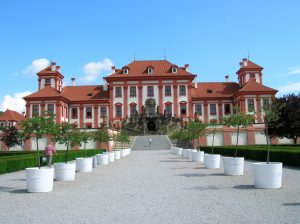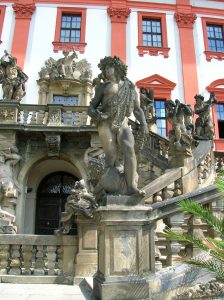Trója Chateau
By Tracy A. Burns
Introduction
Built in the Baroque style for Václav Vojtěch from Šternberk and his family from 1679 to 1685, Trója chateau is located in the district of Trója, across from the zoo. It boasts a unique, captivating exterior as well as a richly decorated interior. Inspired by the Roman villas he had seen during a stay in Italy, French architect Jean Baptiste Mathey designed the nonconventional building with its main entrance facing the French garden. A statue-flanked, two-sided staircase leads to the front doors. Gods such as Hercules, Pallas Athena, and Jupiter make appearances on the staircase as the deities defeat the Titans, thanks to sculptors George and Paul Heermann. The ornate façade also consists of pilasters displaying stars that symbolize the Šternberk clan as well as grapes and rabbit heads. Busts of emperors and fountains dot the garden as do terracotta vases. Take a look at the fountain depicting Neptune with a dolphin at his feet.
 Habsburg Hall
Habsburg Hall
Richly adorned with wall and ceiling frescoes, Trója is at its most impressive in the Habsburg Hall, where frescoes on the ceiling and walls have a Baroque tromp d’oeil effect, and painting pretends to be plastic with illusionary statues, reliefs, and busts. The swirling scenes on the ceiling depict the Christians’ victory over the Turks as the golden triangle in the center stands for the Holy Trinity. Three theological virtues of Hope, Faith, and Love take a trip on a cloud. On the western wall, glance at the defeated Turk flying through the air. Then take a close look at the east wall. Justice is victorious over Injustice as Vice, Folly, Egoism, and Avarice gather, unsuccessful, around a fireplace. The upper part of the wall depicts the Holy Roman Emperor Conrad with Albert Habsburg. Notice the blood on Albert’s robe and the white color that is only under the belt. This scene inspired the Austrians to make red and white their flag colors.
There’s more. On the northern side, a story focusing on Count Rudolf Habsburg, who later became emperor, is visible. While hunting, he ran into a priest who was hurrying to the sick, and the count gave him a horse. The priest foresaw that Rudolf would one day be crowned emperor. Visitors can easily recognize Holy Roman Emperor Leopold I due to his long, dark mane of hair and mustache. Illusionary statues and reliefs of Habsburg emperors, Spanish kings, and others grab one’s attention as well.
Chinese themes
The three rooms evoking Chinese themes amaze with their exquisite wall and ceiling frescoes. On these walls, there are boats, a meandering river, bridges, a town in the background, and a rocky landscape as well as Chinese people, exotic birds, curved roofs, and palm trees. One bridge with black marble pillars is depicted. A gushing waterfall looks as if it is about to tumble into the viewer.
Chapel
The chapel is another gem. The black Madonna features a crowned Virgin and child in clothing designed with golden wiggles, draped around them as if they are wrapped tightly in a blanket. The details of their curly hair are remarkable. The statue is original as is the marble floor. The huge paintings depict Christ’s last hours alive. One work of art shows the crowning of Christ with thorns. Two statues also decorate the room. Notice the fluttering white drapery of Saint John the Evangelist. A stunning reliquary is present as well.
Czech landscape painting
Several rooms make up a gallery of Czech landscape paintings from the 1880s when Classicism gave way to Modernism. It also includes some 20th-century art. In Antonín Hudeček’s painting The Sea, composed of dark blues and greens, one can almost hear the waves crash on the rocks that are reflected in the water. Václav Špála’s Plakánek Valley is a mixture of greens and pinks, simple shapes that create a dynamic whole. In Jindřich Prucha’s Under the Tree a solitary woman, clad in blue, sits under a big tree, surrounded by lush, green scenery. The works of Antonín Slavíček are represented, too.
 Frescoes
Frescoes
Other intriguing ceiling and wall frescoes include one portraying Bacchus, the god of wine, with putti flying around him as he drinks. The other side shows the morning after their drunken escapade, as the putti hold each other up and Bacchus is carried on the shoulders of several figures. Another 17th-century fresco features the 11th labor of Hercules as he gets golden apples.
Furniture
There is astounding furniture in the chateau as well. Exquisite gold and black backs of Empire chairs surround a table with legs also decorated in gold and black. A brown Baroque table boasts diamond shapes on its top. A musical box is displayed in an Empire-style cupboard. A ladies’ desk and a man’s desk both flaunt a style on the edge of Baroque and Classicism. Paintings in the chateau also abound. Many feature dogs, as greyhound, and Scottish terriers, for example. Others portray horses. Most works take up hunting themes.
Historical figures
Some major historical figures stayed in this chateau. Empress Maria Theresa owned it for a while but only spent the night for short periods of time, and Czech historian František Palacký stayed here on several occasions.
Tours
Even though tours are conducted in Czech and English speakers are given an English text, it is more than worthwhile to spend an afternoon strolling through Trója’s Baroque, French garden and perusing its rich, lavish interior.




